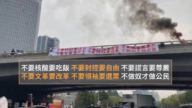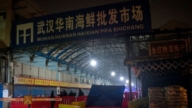【新唐人2012年10月5日讯】军事评论家平可夫在最新一期出版的《汉和防务评论》中说,中国建造的空军基地“糟糕”,打起仗来肯定“战败”。平可夫指出,中国空军的战斗机,即使今日在多数机场的,仍然都是土堆型机堡堆放,或者一字排开,阿拉伯国家这种类型的飞机场,曾经在1967年第三次中东战争的时候,遭到以色列空军攻击,瞬间全军覆没。
平可夫在文章开头就指出,一支真正打过现代化战争的空军,从基地建设就可以看出是否能够首战必胜。J7、J8战斗机,即使今日在中国空军多数机场的,仍然都是土堆型机堡堆放,或者一字排开,他因此感叹,这是支不思进取的空军。
文章说,当今所有空军强国的空军基地建设经验,都是吸取第三次中东战争的结果,就是著名的以色列空军“7点45分攻击”。
当时,苏联模式建设起来的埃及空军,将战斗机一字排开放在机场,或者停放于土堆式的机堡中,以色列空军只用了20分钟就全歼了将近400架各式埃及作战飞机。原埃及飞行员说:“不是没有进行空战,而是根本没有机会进行过战斗。”
时政评论家 伍凡:“中国空军这几十年来没有打过仗。不如埃及和以色列打过。中东的世纪战争,他们的空军都有交往,伊朗,以色列,伊拉克,阿富汗,他们的空军有作战经验,唯独中国这个大国,共产党的空军,他没有作战经验。”
文章说,第三次中东战争之后,苏式、美式空军的国家,相继改变了空军基地的建设式样。吸取这一次战争的经验,当然是如何重点保护被空袭的战斗机,并且强化快速起飞能力。
再看中国的空军基地,这一类最好待遇的机场诸如空3师J10战斗机团,空6师银川基地、空1师赤峰J10团基地等,都修建了简易型一线维修保障机库,同时拥有地下洞库,一般情况下,洞库存在两个出口,张家口的空7师地下洞库有四个出口。至少50%的中国空军基地修建了大型的地下洞库,这是中国吸取第三次中东战争教训的结果。但多数的中国空军机场只有一条跑道,逻辑显然是先藏好飞机为主。
伍凡:“他们现在虽然在沿海第一线,第二线,对保护飞机,建立飞机库,保护机场,有一点概念了,但是毕竟没有产生血的教训,所有这些引擎制造,保护自己机场这些概念,还是没有深入到这些军队里头。只有狠狠吃了亏,流血牺牲之后,你才知道怎样保护机场,保护自己反击的能力。嘴上是这样讲,但是没有实际经验,只有通过战争才能考验。”
真正经历过战争洗礼的国家,如埃及空军、巴基斯坦空军反而不修地下洞库。他们的理论家认为,在镭射制导炸弹、制导武器高度发达的今日空军作战环境中,仅仅有2个或者4个出口的洞库型机库,一旦库门被命中,所有飞机不得不退出战斗,即使不被摧毁,那还不等于失去了制空权?因此埃及空军的逻辑是,不能等,要紧急尽快起飞。
2000年以后,中国的若干空军基地才开始积极修建更多的强化型、隐蔽式堡垒机库。福建前线的机场基本完成了类似机库的建设。空2师的遂溪基地是最先建设美式机库的机场,同时拥有简易型一线维修堡垒型机库。最近空29师也建设了类似的堡垒型机库。
采访编辑/秦雪 后制/肖颜
Chinese Air Force Rated “Lousy"
The latest issue of Kanwa Defense Review published
an article by military commentator Andrei Chang.
It asserted that the Chinese Air Force Base
is “lousy" and would “be defeated" in a war.
The article said, Chinese Air Force fighters are usually
parked in mound-type bunkers or lined up in the airfields.
During the 1967 Middle East War, the Arab air forces,
parked similarly, were easily destroyed in the Israeli attack.
Andrei Chang remarked that in the sense of modern war,
air force base construction is determinant of its first victory.
China’s J7 and J8 fighters are now mostly being parked
in mound-type bunkers or lined up in the airfields.
Chang thus commented
that this is an inertia type air force.
The article said that countries with powerful air forces
have all taken lessons from the 1967 Middle East war.
On June 5, 1967, at 7:45 am, the Israeli Air Force attacked
airfields across Egypt.
At that time, the Egyptian Air Force fighters were all lined up
on the airfield or parked in the mound-type bunkers.
Within 20 minutes, 400 Egyptian fighters were wiped out.
The article cited a former Egyptian pilot as saying,
“It wasn’t defeated in air combat, it failed to even get a chance to fight back.”
Critic Wu Fan: “Over past decades, Chinese Air Forces
haven’t been in wars, but both Egypt and Israel have.
Air Forces of Iran, Israel, Iraq and Afghanistan
have all had combat experiences, too."
Chang’s article said, after the 1967 Middle East War,
Air Forces of both the former Soviet Union and the US changed the construction of their air force bases.
Constructions were designed to protect fighters in air raids,
and to accelerate fighter’s take-off.
Andrei Chang pointed out that China’s best air force bases
have built simple aircraft hangars and underground caverns.
The 7th Air Division stationed in Zhangjiakou built four exits
for each underground hangar compared to the usual two.
At least 50% of the Chinese Air Force bases learnt from the
1967 war by building underground caverns, the article said.
However, in most Chinese Air Force airports
there is only one runway.
Andrei Chang commented that the logic behind it
is aiming to hide the fighters.
Wu Fan: “They have some idea on protecting fighters,
but they still haven’t had any experience in war.
The air force still lack knowledge about engine production
and airfields protection, among others concepts.
How to protect the airfield and counterattack capability?
This can only be learnt by experiencing a real war.
It’s useless to give only lip service
without practical experiences.”
After having experienced wars, the air forces of Egypt
and Pakistan have not constructed underground caverns.
As underground caverns can be easily targeted
by today’s laser-guided bombs and weapons.
That would amount to losing air supremacy.
Therefore, the Egyptian Air Force prioritized to accelerate
fighters’ take-off, according to Chang’s article.
Andrei Chang revealed that it was not until after 2000,
when some of China’s air force bases began to build more fortified and sheltered aircraft bunkers.
Fujian’s frontline airfield
has almost completed such constructions.
The 2nd Air Division based at Suixi built it’s first US-style
aircraft bunkers and simple aircraft fortress-type hangars.
Recently, the 29th Air Division has constructed
similar fortress-type hangars.




























